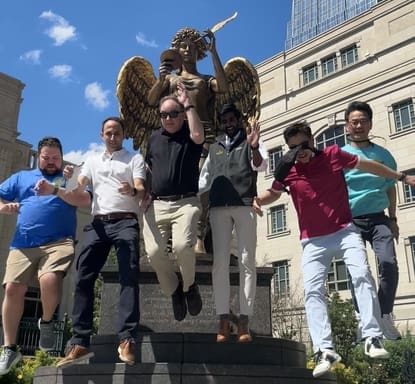Conflict is not a dirty word.- at least at thriving companies that is. This big scary word has gotten a bad rap over the years as the highlighted word in HR complaints, office memos, and hushed conversations around the water cooler. But how common is conflict anyway? According to expert team builders, it’s not only common, but it’s also essential to building healthy teams! Working through conflicts can actually strengthen the connection between coworkers and make them feel like they can be heard even when it feels intense. Team building gurus know that fear of conflict is one of the first markers of a team in decline. But there’s hope! The strongest teams are not afraid of conflict, but know how to resolve it in healthy ways. Removing conflict from the naughty list through conflict resolution exercises could make or break teams that are relying on each other.
Conflict Resolution Team Building Activities
So you’ve read the list of our top team building games and you’re back for more team bonding and conflict resolution. We’re here for you!
1. Scavenger Hunts with cityHUNT
CityHUNT’s scavenger hunts are a premier choice for team building, blending adventure with problem-solving. Designed to boost collaboration and communication, these hunts involve teams navigating through a series of clues and challenges to find hidden items or complete tasks. The experience starts with a Discovery Call to tailor the hunt to your needs, followed by a detailed proposal and planning phase to ensure everything is customized for your group. On the day of the event, your team will use a state-of-the-art mobile app or benefit from on-site Adventure Guides to guide them through the hunt. With elements like real-time instructions, clues, and a leaderboard, teams are encouraged to work together, think creatively, and adapt to challenges. Whether in a city or virtually, CityHUNT’s scavenger hunts offer an engaging way to foster teamwork and resolve conflicts in a fun, dynamic setting.
2. Arm Wrestling
I know you’re thinking that you already have this one down, but this twist on the classic actually shows that working together helps to score more points than an aggressive stalemate. Here’s how to play: two people are paired up and instructed to take the position of the classic showdown without starting the countdown. Next, they are told that they will get one point for each time that the back of their partner’s hand touches the table. With ten seconds on the clock, the most successful teams quickly decide to work together by “pinning” each other back and forth without resistance. The least successful teams play the traditional way-thereby falling behind by choosing brute force. The explanation of the winners and their tactics is the “Ah-ha” moment that really drives the point home.
3. Knot or no Knot
That is the question- and the key to this next conflict resolution game. The facilitator takes a length of rope-preferably one with stripes or patterns and coils it on the floor. The team is then told that they will be picking up the ends of the rope and pulling. But before they do, they must vote and unanimously agree on whether the rope will or will not end up with a knot. This exercise really allows groups to examine how they stand their ground, work with strong opinions, and learn natural consequences. After the rope is pulled, allow for some time to talk through why they did or did not change their opinions, or go against their strong feelings. It’s sure to bring out exciting views on team dynamics!

4. The Orange Negotiation
Buckle up for this intense game that will ultimately require not only collaboration but learned skills in emotional regulation as well. In this exercise, the group is divided into two teams “A” & “B” and each team is given a secret directive as to why they must purchase the orange owned by the farmer. It is a very rare variety and the last of its kind. Team “A” is told that they need the pulp to produce a high yield pharmaceutical that protects pregnant women from a deadly disease. Team “B” is told they need the rind to create a nuclear component that is needed to avoid the meltdown of a reactor, threatening thousands of lives. Only one spokesperson can negotiate with the farmer at a time. The most successful negotiators begin to collaborate with the other team instead of fighting harder for the last orange.
5. Nine Dots Challenge
This is a quick brain buster that can help reveal the creativity and resilience of the player. First, put nine dots on a piece of paper in a 3×3 configuration. Now, without lifting your pencil, connect them all with only four straight lines. Stumped? Here’s a spoiler on how to do it: Starting in any corner, draw a diagonal line to the opposite corner. Second, make a horizontal line from that dot to the dot at the other side of your square, but continue onward the length of a fourth invisible dot. Third, draw diagonally through two middle dots, again continuing your line to the next imaginary dot. Finally, draw a vertical line through the two remaining dots.
6. Old Lady/Young Lady Optical Illusion
This exercise really digs into the experience of shared, or not-so-shared, experience. This relies on choosing one of the images meant to induce the “Gestalt Switch”. Sit down your team and tell them that you are going to show them a series of images for 10 seconds each. Have them make a list of what they see in each image. Once complete, have them share their lists with each other and tell them that they should all be the same since they saw the same images. But are they?
7. Pushy Pairs
This exercise highlights just how important conflict resolution is. The longer we go without it, the harder the toll on our relationships. Ask two people to stand in front of each other with feet hip-width. Now have them place their hands on each other’s shoulders and push as hard as they can for 20 seconds. Once they let go, ask them to describe to their partner what a relief it is to not be in “pushy” conflict anymore.
8. Win as Much as You Can
No, this game isn’t based off of a cheesy motivational poster, but it does ask a burning question: How much is trust worth? Would you betray the larger collective for significant short term gain?
“Scenario: This exercise is analytically similar to both the Oil Pricing and Pepulator Pricing exercises. Participants’ sole objective is to maximize their own points with complete indifference to the other participants. Participants are to play either an X or a Y and, depending on other participants’ choices, a payoff is awarded each round. Only before rounds 5, 8 and 10 are players allowed to confer with each other.
Mechanics: This exercise is played in ten quick rounds. Players are grouped into fours. The explanation of the exercise should take no more than 5 minutes. The ten rounds should take about 15 minutes, while debriefing can take from 30 to 45 minutes.”
9. Divide the Loot
How generous are you, really? In this exercise, each player is given an amount of fake money and asked to make a contribution to the group pot (no telling how much you gave!). After all contributions are made, the total is announced, and without telling how much each player contributed, the team negotiates how to divide the cache.
10. Chief Negotiator
As a variation of “ win as much as you can” players are asked to choose either a self-interest card or a group-benefit card. If everyone chooses the self-interest card (A), then everyone in the group loses $2. If everyone chooses the group-benefit card (B), then every player wins $2. However, if only one player plays A and everyone else plays B, the A player wins $10, and all the B players each lose $2.
11. Winner/Loser
They say positivity is a lens, not an emotion, and this game highlights how to put that into practice. Teams of two are paired up and asked to recall a negative situation in their life. It can be from work or home, but it has to be true. After person “A” tells the story in a negative light, they share the story again, focused on the positive aspects. Partner “B” helps them to explore the silver lining before switching roles.
12. The Trust Fall
The Trust Fall is a classic team-building activity designed to build trust and support among team members. This simple yet powerful exercise helps participants experience firsthand the importance of reliance and confidence in their teammates. By fostering a sense of security and mutual support, the Trust Fall serves as a foundational activity for enhancing team cohesion and resolving conflicts effectively.
13. Building Bridges
The “Building Bridges” activity is a dynamic and engaging team-building exercise that challenges participants to work collaboratively under constraints. Teams are tasked with designing and constructing a bridge using a limited set of materials. This activity highlights the importance of creativity, resource management, and effective communication, while also providing insights into how teams can overcome challenges and achieve their goals together.
Why use conflict resolution games and activities?
While conflict resolution can feel like a daunting and emotionally heavy task at first, the reality is that resolving conflict through play is the perfect solution. Creating a safe container through play allows real frustrations to be expressed in a healthy way. Often the repression of anger and resentments can really skew our original trigger into something that is hard to express in words. In fact, scientists believe that our core emotions are felt in the limbic brain, and area that is non-verbal! Luckily, play is a biology hack that not only gets to the real roots of conflict but helps to remove some of the fear in feeling it in the first place. This doesn’t mean we have to have an epic duck, duck, goose battle every time someone starts to argue, however. Once we create a pattern of beneficial and safe conflict resolution, teams are well on their way to mindsets that strengthen bonds instead of breaking them. The skills that we learn through play begin to become a natural part of team dynamics, both in and out of the office. As humans, we are born with an insatiable need for connection. Regularly employing conflict resolution team building activities helps us understand that the only thing more natural than conflict, is connection.
Ready, Set, PLAY!
With ten conflict resolution team building activities in your coffers, there’s no reason to frame conflict resolution in a way your team dreads. Push back the conference room chairs and get to bonding! Research shows the sooner the better when it comes to healthy dynamics. Festering resentments, unresolved conflict, and secret battles may not seem obvious until the whole tower is crumbling, but we know you’re equipped to stop it in its tracks. Resolve conflict, build stronger teams, and let the people play.
Let’s Connect!
You’re not alone in this team building journey. CityHunt designs customized scavenger hunts across dozens of U.S. cities. Our techniques come from teambuilding research at Stanford and the University of Pennsylvania! Just call us at (1-877)-HUNT-FUN and tell us about your company and its unique team building needs. Or, fill out our contact form to start the conversation today. A live-person will reach out within 24 hours.






